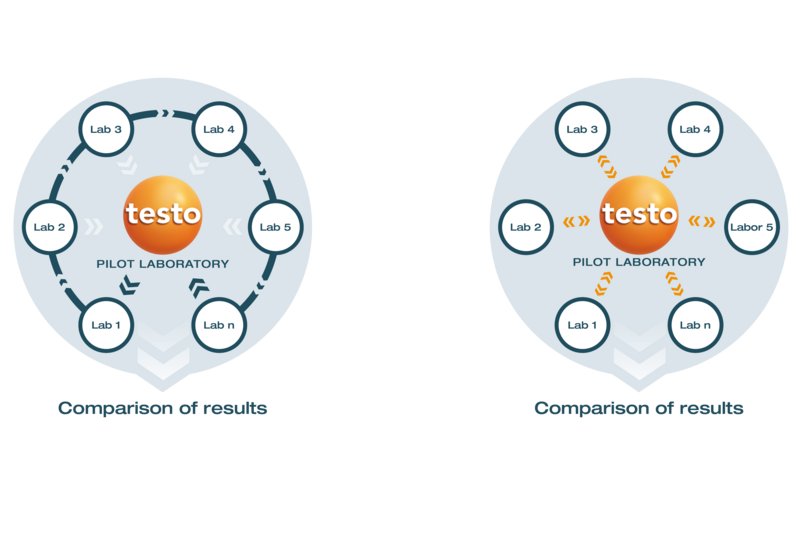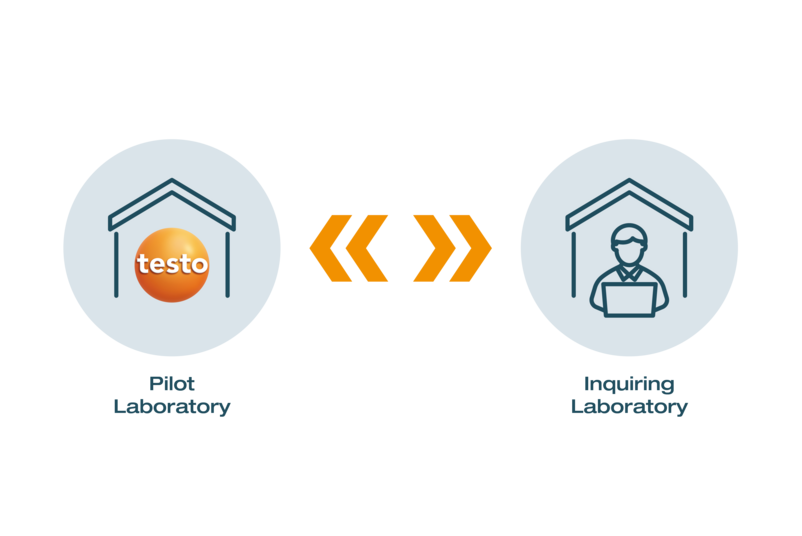Knowledge from the field of proficiency testing and comparative measurement
The knowledge area proficiency tests & comparative measurements answers questions on the topics of interlaboratory comparisons and bilateral comparisons, also known internationally as Interlaboratory Comparison (ILC).
Here you will find answers to the following questions:
- What is a proficiency test or comparative measurement?
- Are proficiency tests and comparative measurements carried out at Testo Industrial Services in both accredited and non-accredited settings?
- What types of proficiency tests and comparative measurements are available?
- What are the tasks of a proficiency testing and comparative measurement provider?
- What is understood by the term pilot laboratory?
- Who can participate in a proficiency test or comparative measurement?
- What are the necessity and contents of proficiency tests & comparative measurements?
- What advantages do the Comparative measurements offer?
- Which proficiency tests or comparative measurements does Testo Industrial Services currently offer?
What is a proficiency test or comparative measurement?
"Evaluation of the performance of a participant according to previously established criteria by comparisons between laboratories" (DIN EN ISO/IEC 17043:2010).
The performance of a measurement or test task by several (at least 2), independent laboratories. The results of the different laboratories are compared and evaluated by the provider of the test. The goal is to determine the performance of the participants under equal conditions. In this way, the laboratories are given the opportunity to prove their competencies or to identify sources of error as well as potential for improvement.
Are proficiency tests and comparative measurements carried out at Testo Industrial Services in both accredited and non-accredited settings?
Testo Industrial Services is a DIN EN ISO/IEC 17043:2010 accredited provider of proficiency tests and comparative measurements in the thermodynamic and dimensional environment. Our current scope of accreditation can be found in our accreditation certificate.
Suitability tests and comparative measurements can also be carried out within a non-accredited framework in accordance with the current service portfolio of our calibration laboratory. We make no distinction in terms of methodology between accredited and non-accredited proficiency tests and comparative measurements. Both cases follow the requirements of DIN EN ISO/IEC 17043:2010.
In the future, we plan to expand our accreditation portfolio as a provider of proficiency testing and comparative measurements with additional measurement parameters and measuring equipment.
What types of proficiency tests and comparative measurements are available?
Ring comparison:
Proficiency tests are often also referred to ring comparisons/ring tests. Within an ring comparison/ring test, a specific measurement or test task is carried out by a group of laboratories independently of each other and one after the other. There are ring-shaped and star-shaped forms.
Bilateral comparison:
In a bilateral comparison, two laboratories are compared with each other, the pilot laboratory and the requesting laboratory. The advantage here is that the requirements of the laboratory can be customised to a certain extent. In addition, the implementation time is generally shorter compared to the interlaboratory comparison.
What are the tasks of a proficiency testing and comparative measurement provider?
Testo Industrial Services is the provider responsible for planning and organizing proficiency tests and comparative measurements. In addition to the coordination on time, content and technical issues, the evaluation, using statistical methods and reporting, is also carried out by the provider.
What is understood by the term pilot laboratory?
The pilot laboratory is responsible for the characterisation of the calibration items and carries out the intermediate tests. In addition, it can set the reference value.
Qualifications:
- Many years of experience in the measurand of the calibration object
- Accreditation for the corresponding calibration object and the procedure with the intended scope
Responsibilities:
- Stability and homogeneity tests
- Carrying out the intermediate examination
Who can participate in a proficiency test or comparative measurement?
For example, accredited testing and calibration laboratories as well as testing and calibration laboratories seeking accreditation can take part. It is important that the participants can carry out the calibration according to the required procedures and that the measurement result has a measurement uncertainty according to EA-4/02:2022. As the performance criterion is the EN value by default.
What are the necessity and contents of proficiency tests & comparative measurements?
The participation in proficiency tests and comparative measurements is mandatory for accredited laboratories in accordance with DIN EN ISO/IEC 17025. These comparisons represent an important element for the validation of calibration procedures and results in the quality management of a laboratory and offer an external method for quality assurance of the measurement procedures.
Within the proficiency tests and comparative measurements , identical test equipment is analysed by different laboratories according to the same specifications. As a provider, Testo Industrial Services compares the measurement results obtained and makes statements about the general measurement uncertainty and the quality of the measurements of all participants.
What advantages do the comparative measurements offer?
Proficiency tests and comparative measurements are used in the following cases:
- Quality assurance of laboratory tests and measurements
- Verification of the measurement uncertainty of a measurement method
- Comparison of calibration processes with other laboratories
- Compliance with the requirements according to DIN EN ISO/IEC 17025:2018
- Proof of competence towards customers, superiors and authorities
Which proficiency tests or comparative measurements does Testo Industrial Services currently offer?
Testo Industrial Services always offers different proficiency tests and comparative measurements, which are carried out in a ring-shaped manner. Individual bilateral settlements are also offered. Make a note of our upcoming proficiency tests or comparative measurements now or request a bilateral comparison.

